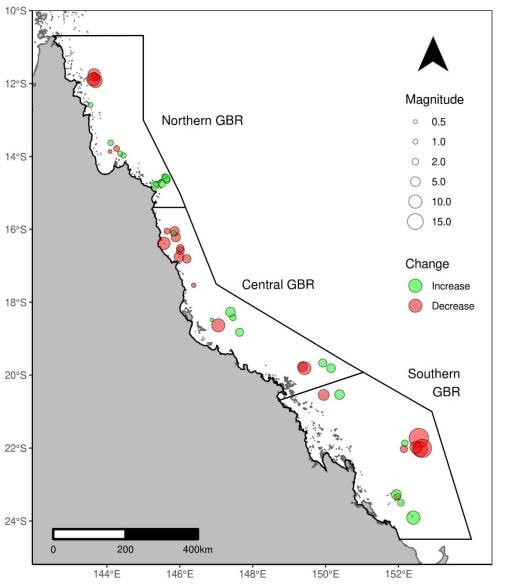Report shows ‘Unparalleled’ decline of coral on the Great Barrier Reef

A NEW REPORT by the Australian Institute of Marine Science has revealed a decline in coral cover across the Great Barrier Reef, which they attribute to “a period of intense disturbance activity.”
The results from the AIMS report, published today, are based on their Long-Term Monitoring Program (LTMP), which includes comprehensive surveys dating back 30 years.

(Image credit: AIMS)
“A fourth wave of crown-of-thorns starfish, coupled with a cluster of severe tropical cyclones and major bleaching events have caused widespread coral declines on a spatial scale which is unparalleled in the history of LTMP surveys,” the report reads.
According to the report, coral juveniles “occurred at densities favourable for recovery,” but this is reliant on the absence of any further disturbances, which scientists say is unlikely due to increasing temperatures as a result of anthropogenic global warming.
Hard coral cover in the northern part of the reef managed to increase from 11 per cent in 2017 to 14 per cent in 2019, but the report adds that this is “close to the lowest levels recorded” in past surveys.
AIMS explained that the small increase of coral cover on the northern parts of the reef could be attributable to the exclusion of reefs previously surveyed.
“Inshore and mid-shelf reefs in the Northern GBR were among the most severely impacted by the mass coral bleaching events of 2016 and 2017,” the report reads.
“However, eight reefs that had been surveyed previously could not be resurveyed in 2019 due to safety concerns.”
The report also revealed that, despite aerial surveys showing that the southern reefs had escaped a bleaching event, coral was declining due to an outbreak of crown-of-thorns starfish.
The results published in this report mirror those published in Nature in April 2018, which also found that 30 per cent of the corals on the reef had died over a nine month period in 2016.
The author of that paper, coral biologist Terry Hughes, the director of the ARC Centre of Excellence for Coral Reef Studies, says that anthropogenic global warming is the leading cause of this decline in coral on the reef.
“Compared to cyclones or starfish, the mass bleaching events that affected 2/3 of the reef over two consecutive summers are far more significant,” Terry says.
“The elephant in the room is anthropogenic global warming, and Australia’s ever-rising greenhouse gas emissions.”
“The very limited, slow recovery after bleaching is what we expected, because there are fewer breeding adult corals alive to produce larvae due to heat extremes.”
That the southern reef was heavily affected by the crown-of-thorns, Terry says, suggests that the starfish control program doesn’t actually work.
“The funding would be better spent on reducing water pollution – the most likely trigger for starfish outbreaks,” he says.
WWF-Australia Head of Oceans Richard Leck emphasised the need to act on climate change.
“The federal government’s own research institute says coral cover is in serious decline…” he says.
“Australia must urgently reduce its dependence on fossil fuels and rapidly speed up the transition to a renewable economy.”




